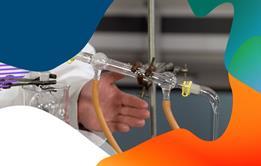Learn how to determine the relative rates of reaction for the hydrolysis of haloalkanes
The following video from MaChemGuy outlines the nucleophilic substitution reaction mechanism for the hydrolysis of haloalkanes.
Questions you can ask your students:
- What happens to the polarity of the C-X bond as you go down the Group 7 halogens?
- What are the products of the hydrolysis if the nucleophile is water and not hydroxide ions?
- What variable could we measure to determine the rate of reaction?
- How would we measure this variable?
When water is used as the nucleophile, the reaction can be expressed in the following two ways:
R-Cl (aq) + H2O (l) → R-OH (aq) + Cl- (aq) + H+ (aq)
Or
R-Cl (aq) + H2O (l) → R-OH (aq) + HCl (aq)
Whichever expression you prefer, it’s important for students to understand that hydrochloric acid is formed rather than hydrogen chloride, which is a gas.
A second video from MaChemGuy looks at measuring the relative rates of hydrolysis by measuring the time taken for silver halide precipitates to form. The experiment occurs from 5:38 and an explanation for the increase in reaction rate down Group 7 begins at 7:59.
Questions you can ask your students:
- Why is ethanol added to the test tubes?
- Why is it important to use chloro-, bromo- and iodoalkanes with the same carbon chain length?
- What sources of possible error can you identify in the experiment?
- How do you ‘know’ when to stop the timer?
- To how many decimal places should you record the time?
- To how many significant figures should you calculate the rate of reaction?
This final video from FranklyChemistry shows just the experimental technique in isolation, with the three test tubes shown alongside one another.
Also check out:
- The hydrolysis of 2-bromo-2-methylpropane – this one-hour experiment allows students to determine the order of the reaction and show that it follows an SN1 mechanism.
- Challenging medicines: physiochemical properties – a range of experiments investigating dissolution, pKa and rates of hydrolysis of everyday tablets.
Additional information
We have collated these videos of key practical experiments to support remote teaching as part of our response to Covid-19. Teachers requested resources to help them deliver practical content without access to laboratories or equipment. We are developing further resources and welcome feedback to help us produce those you most need. Please email us or use the comment section below.
Practical videos | 16–18 years

Videos of key practical techniques and apparatus for revision, flipped learning or remote teaching
- 1
- 2
- 3
- 4
- 5
- 6
- 7
- 8
- 9
- 10
- 11
 Currently
reading
Currently
reading
Rates of hydrolysis
- 13











































No comments yet